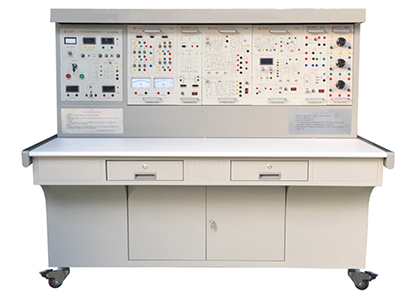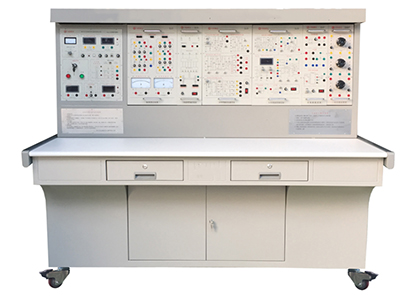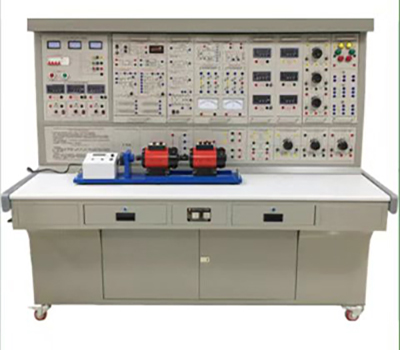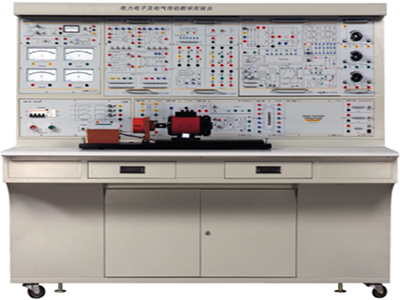GL-DLDZ-1 Power Electronics Technology and Motor Control Experimental Device is carefully developed based on the requirements of the latest unified textbooks of colleges and universities, such as "Power Electronics Technology" (4th edition) and "Electric Drive Automatic Control System" (3rd edition), absorbing the advantages of similar products at home and abroad, and taking full account of the current situation and development trend of the laboratory. Among similar products, it has the advantages of reasonable structure, complete functions, good reliability, and high cost performance.
GL-DLDZ-1 Power Electronics Technology and Motor Control Experimental Device
Ⅰ、Overview
GL-DLDZ-1 Power Electronics Technology and Motor Control Experimental Device is based on the requirements of the latest unified textbooks of colleges and universities, such as "Power Electronics Technology" (4th edition) and "Electric Traction Automatic Control System" (3rd edition). It absorbs the advantages of similar products at home and abroad, fully considers the current situation and development trend of the laboratory, and is carefully developed. It has the advantages of reasonable structure, complete functions, good reliability, and high cost performance among similar products.
Ⅱ、Features
1. Strong comprehensiveness This device integrates experimental projects such as power electronics, semiconductor conversion, AC and DC speed regulation, AC frequency conversion, motor control, and control theory.
2. Strong adaptability It can meet the experimental teaching of corresponding courses in various schools. The depth and breadth can be flexibly adjusted according to needs. Popularization and improvement can be organically combined according to the progress of teaching. The device adopts a building block structure, which is easy to replace. If you need to expand functions or develop new experiments, you only need to add components, and it will never be eliminated.
3. Strong complete set From special power supplies, motors and other experimental components to special wires for experimental connections, the performance and specifications of the supporting components are closely matched with the needs of the experiment.
4. Strong intuitiveness Each experimental pendant adopts a separated structure, with clear panel diagrams and lines, clear tasks for each pendant, and convenient operation and maintenance.
5. Strong scientificity The device occupies a small area, saves experimental space, and reduces infrastructure investment; the supporting small motors are specially designed to simulate the characteristics and parameters of small and medium-sized motors; small motors consume less power, save energy, have low experimental noise, are neat and beautiful, and improve the experimental environment; the experimental content is rich and the design is reasonable. In addition to deepening theoretical knowledge, design experiments can also be combined with actual practice.
6. Strong openness The control panel power supply is isolated by a three-phase isolation transformer, and is equipped with a voltage-type leakage protection device and a current-type leakage protection device to ensure the safety of the operator; each power output has monitoring and short-circuit protection functions, and each measuring instrument has a reliable protection function, which is safe and reliable to use; the control panel is also equipped with an experimental manager to provide a unified standard for the assessment of students' experimental skills. Since the entire set of equipment has been carefully designed, with reliable components and reliable processes as a guarantee, the product performance is excellent, which creates conditions for open laboratories.
7. Strong advancement The device focuses on the new device height. On the basis of retaining the thyristor experiment, it adds a large number of modern power electronics technology experiments on the characteristics of new devices, the driving of new devices and typical new device applications, so that students can have sufficient knowledge and understanding of new devices and keep up with the pace of the times.
III、Scope of application
This device covers the experimental projects required by professional courses such as "Power Electronics Technology" (or Semiconductor Converter Technology), "DC Speed Regulation", "AC Speed Regulation", "Motor Control", "Electric Traction Automatic Control System" and "Control Theory" offered by various colleges and universities.
IV、Technical performance
1. Input power: three-phase four-wire (or three-phase five-wire 380V±10% 50HZ)
2. Working environment: temperature -10℃~+40℃, relative humidity<85% (25℃)
Altitude<4000m
3. Device capacity:<1.5KVA
4. Dimensions: 187×73×162 cm3
V、Device configuration
1. DL01 power control panel
(1) AC power supply (all with overcurrent protection measures)
AC power supply: DC speed control gear is three-phase AC 200V/3A
AC speed control gear is three-phase AC 240V/3A
(2) High-voltage DC power supply
Excitation power supply: 220V (0.5A), with output short-circuit protection.
(3) Digital instruments
① AC digital voltmeter: can indicate the input line voltage of the three-phase power grid through the band switch below it, with an accuracy of 1.0 level;
② One true effective value AC digital voltmeter: measurement range 0~500V, automatic range judgment and automatic switching, accuracy 0.5 level, three-and-a-half-digit digital display, providing voltage indication for the AC speed regulation system;
③ One true effective value AC digital ammeter: measurement range 0~5A, automatic range judgment and automatic switching, accuracy 0.5 level, three-and-a-half-digit digital display, with over-range alarm, indication and total power cut-off functions, providing current indication for the speed regulation system;
④ One DC digital voltmeter: measurement range 0~300V, three-and-a-half-digit digital display, input impedance of 10MΩ, accuracy 0.5 level, providing voltage indication for the reversible speed regulation system;
⑤ One DC digital ammeter: measurement range 0~5A, three-and-a-half-digit digital display, accuracy 0.5 level, with over-range alarm, indication, total power cut-off functions, providing current indication for the reversible speed regulation system. (4) Personal safety protection system
One set of three-phase isolation transformers: The three-phase power supply first passes through the three-phase leakage protector, and then through the key switch and contactor to the isolation transformer, so that the output is isolated from the power grid (floating ground design), which plays a certain protective role in personal safety.
Voltage type leakage protector 1: Protects against leakage in the line before the isolation transformer, trips the contactor in the control panel, and cuts off the power supply.
Voltage type leakage protector 2: Protects against leakage in the line after the isolation transformer and the wiring during the experiment, sends out an alarm signal and cuts off the power supply to ensure personal safety.
Current type leakage protection device: If there is leakage in the control panel, the leakage current exceeds a certain value, and the power supply is cut off.
Experimental connection wires and sockets: Strong and weak current connection wires and sockets are separated and cannot be mixed. Strong current connection wires and sockets adopt a fully enclosed process, which is safe, reliable and prevents electric shock.
2. DL02 experimental table
3. DJQ03-1 stainless steel motor rail, optical encoder speed measurement system and digital tachometer
4. DJQ27 three-phase adjustable resistor (900Ω×2/0.41A per group)
5. DL03 thyristor main circuit
6. DL04 three-phase thyristor trigger circuit
7. DL05 thyristor trigger circuit experiment
8. DL06 motor speed control experiment (I)
9. DL06-1 motor speed control experiment (II)
10. DL07 DC chopping experiment
11. DL08 given and experimental devices
12. DL09 new device characteristics experiment
13. DL10 adjustable resistance and capacitor box
14. DL11 single-phase voltage regulation and adjustable load
15. DL12 transformer experiment
16. DL13 power device drive circuit experiment box
17. DL14 single-phase AC-DC-AC frequency conversion principle
18. DL15 automatic control principle experiment
19. DL16 automatic control principle experiment
20. DL17 double closed-loop H-bridge DC/DC conversion DC speed regulation System
21. DL18 Motor speed control experiment (II)
22. DL19 Half-bridge switching power supply
23. DL20 DC chopper circuit
24. DL21 Chopping AC voltage regulation circuit
25. DL22 Single-phase voltage regulation/power regulation circuit
26. DL23 Single-ended flyback isolated switching power supply
27. DL24 PS-ZVS-PWM soft switching technology
28. DL25 Rectifier circuit active power factor correction
29. DL26 Single-ended current feedback isolated switching power supply
30. DL27 Boost, buck and compound chopper circuit
31. DL28 Three-phase asynchronous motor variable frequency speed control
32. DL29 Single-phase intelligent power and power factor meter
33. DJQ07-1 DC generator
34. DJQ09 DC shunt motor
35. DJQ11 three-phase wire-wound asynchronous motor
36. DL30 wire-wound asynchronous motor rotor special box
37. DJQ17 single-phase resistance start asynchronous motor
38. DJQ20-1 three-phase squirrel cage asynchronous motor
39. Experimental connection line
VI、Experimental project of Power Electronics Technology and Motor Control Experimental Device
(I) Power electronics technology experimental project
1. Single junction transistor trigger circuit
2. Sine wave synchronous phase shift trigger circuit experiment
3. Sawtooth wave synchronous phase shift trigger circuit experiment
4. Single-phase half-wave controlled rectifier circuit experiment
5. Single-phase bridge half-controlled rectifier circuit experiment
6. Single-phase bridge full-controlled rectifier and active inverter circuit experiment
7. Three-phase half-wave controlled rectifier circuit experiment
8. Three-phase bridge half-controlled rectifier circuit experiment
9. Three-phase half-wave active inverter circuit experiment
10. Three-phase bridge full-controlled rectifier and active Inverter circuit experiment
11. Single-phase AC voltage regulation circuit experiment
12. Single-phase AC power regulation circuit experiment
13. Three-phase AC voltage regulation circuit experiment
14. DC chopper circuit principle experiment
15. Single-way thyristor (SCR) characteristic experiment
16. Gate turn-off thyristor (GTO) characteristic experiment
17. Power field effect tube (MOSFET) characteristic experiment
18. Power transistor (GTR) characteristic experiment
19. Insulated bipolar transistor (IGBT) characteristic experiment
20. Gate turn-off thyristor (GTO) drive and protection circuit experiment
21. Power field effect tube (MOSFET) drive and protection circuit experiment
22. Power transistor (GTR) drive and protection circuit experiment
23. Insulated bipolar transistor (IGBT) drive and protection circuit experiment
(II) Experiments on typical power electronic device circuits
1. Single-phase sinusoidal pulse width modulation (SPWM) inverter circuit experiment
2. Full-bridge DC/DC conversion circuit experiment
3. Performance study of half-bridge switching power supply
4. Single-ended flyback isolated switching power supply experiment
5. Single-ended current feedback externally excited isolated switching power supply experiment
6. Performance study of DC chopper circuit (step-down chopper circuit, step-up chopper circuit, step-up and step-down chopper circuit, Cuk chopper circuit, Sepic chopper circuit, Zeta chopper circuit)
7. Step-up, step-down and compound chopper circuit experiment
8. Single-phase chopper-controlled AC voltage regulation circuit experiment
9. Rectifier circuit active power factor correction experiment
10. Soft switching technology experiment
(III) DC motor speed regulation experiment
1. Determination experiment of thyristor DC speed regulation system parameters and link characteristics
2. Debugging of main units of thyristor DC speed regulation system
3. Single closed-loop irreversible DC speed regulation system experiment
4. Double closed-loop irreversible DC speed regulation system experiment
5. Logic non-circulating reversible DC speed regulation system experiment
6. Three closed-loop staggered selection non-circulating reversible DC speed regulation system experiment
7. Double closed-loop control DC pulse width speed regulation system (H bridge, IGBT)
(Ⅳ) Frequency conversion principle experiment
1. Three-phase sinusoidal pulse width modulation (SPWM) frequency conversion principle experiment
2. Three-phase saddle wave (third harmonic injection) pulse width modulation frequency conversion principle experiment
3. Three-phase space voltage vector SVPWM frequency conversion principle experiment
4. V/F curve measurement under SPWM modulation mode
5. V/F curve measurement under saddle wave modulation mode
6. V/F curve measurement under space voltage vector modulation mode
7. Magnetic flux trajectory observation experiment under different frequency conversion modes
(Ⅴ) AC motor speed regulation system Experiment
1. Double closed-loop three-phase asynchronous motor voltage regulation and speed control system experiment
2. Double closed-loop three-phase asynchronous motor series pole speed control system experiment
3. Single-phase sinusoidal pulse width modulation SPWM variable frequency speed control system experiment
4. Three-phase sinusoidal pulse width modulation (SPWM) variable frequency speed control system experiment
——Can be connected to a computer for experiment, and there is also a programmable controller (PLC) interface
5. Three-phase saddle wave pulse width modulation variable frequency speed control system experiment
——Can be connected to a computer for experiment, and there is also a programmable controller (PLC) interface
6. Three-phase space voltage vector SVPWM variable frequency speed control system experiment
——Can be connected to a computer for experiments, and a programmable controller (PLC) interface is also available
(VI) Experimental projects on the principle of automatic control
1. Simulation of typical links of the control system
2. Time domain response and parameter determination of the first-order system
3. Transient response analysis of the second-order system
4. Transient response and stability analysis of the third-order system
5. Dynamic performance of the PID controller
6. Dynamic correction of the control system
7. Test of the frequency characteristics of typical links
8. Test of the frequency characteristics of linear systems
9. Sampling and recovery of signals
10. Simulation of typical nonlinear links
11. Phase plane analysis of nonlinear systems

Synchronous PC version:
GL-DLDZ-1 Power Electronics Technology and Motor Control Experimental Device https://www.biisun.com/home/category/detail/id/158.html


 Italian
Italian German
German Russian
Russian Turkish
Turkish Portuguese
Portuguese Spanish
Spanish French
French





